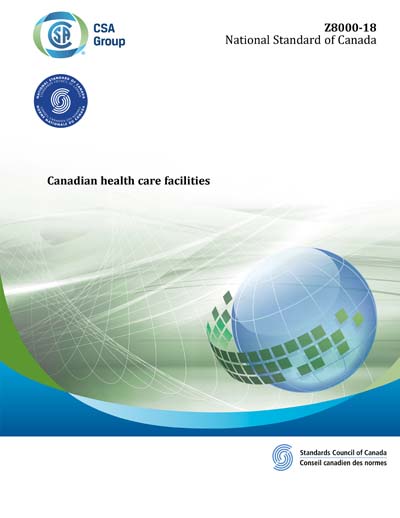Most recent
CSA Z8000-2018
Canadian health care facilities
Preface This is the second edition of CSA Z8000, Canadian health care facilities. It supersedes the previous edition published in 2011. It is part of a series of Standards related to health care facility engineering and sets forth planning, design, and construction requirements intended to support five key objectives for health care facility design (the OASIS principles): ? operational effectiveness and efficiency; ? accessibility; ? safety and security; ? infection prevention and control; and ? sustainability. Changes in this edition include a) update and reorganization of the planning clauses to better align with provincial/territorial procurement practices; b) greater detail on the make-up the inter-disciplinary team and its role in planning; c) new and updated information on mock-ups and simulations as part of planning and design; d) revision to occupational health and safety (OHS), patient safety, and accessibility provisions; e) update to the infection prevention and control requirements to reflect advances in science, technology, and clinical practice related to infection prevention and control (IPC); f) addition and expansion of material on infant and pediatric treatment spaces; g) revisions and additions to address specific needs of pediatric patients and their families; h) modification of the wayfinding section to align with the new CSA standard on wayfinding, CSA Z317.14; i) expansion of the clauses addressing risk assessment and catastrophic event planning; j) reorganization of ambulatory care and procedures clauses to provide clear guidance and requirements for low-acuity community health facilities; k) addition of clauses specifically addressing long-term care facilities; l) updated requirements for equipment, logistics, and information technology planning and support; m) adjustment of room size requirements where needed to align with provinces/territories (P/T) planning guidelines and best practice; n) updates to architectural requirements to accommodate newer building designs, technologies, and construction practices; o) updates to the medical device reprocessing and medical laboratories clauses by experts in those areas; and p) new and revised material on technology integration, reflecting the increasing reliance on mobile communications, electronic patient records, building management systems, and robotics. CSA Group acknowledges that the development of this Standard was made possible, in part, by the financial support of the governments of Alberta, British Columbia, Manitoba, New Brunswick, Newfoundland and Labrador, Northwest Territories, Nova Scotia, Nunavut, Ontario, Prince Edward Island, Quebec, Saskatchewan, and Yukon, as administered by the Canadian Agency for Drugs and Technologies in Health (CADTH). This Standard has been developed in compliance with Standards Council of Canada requirements for National Standards of Canada. It has been published as a National Standard of Canada by CSA Group. Scope 1.1 General 1.1.1 This Standard describes essential elements and specific requirements for the planning, design, and construction of HCFs. It applies to all facilities, public or private, that provide health care treatments, health-related services, or diagnostic testing services, regardless of type, size, location, or range of services. This Standard applies to the following facility types: a) inpatient, outpatient, or combined hospitals; b) facilities providing outpatient diagnosis and treatment services; and c) specialty inpatient centres and residential care facilities. Note: Owing to differences in terminology across the country, it is not possible to provide a comprehensive list of all facilities covered by this Standard. The facilities listed in Items a), b), and c), and in Table 1.1 are examples only. Additional examples are listed in Annex B. 1.1.2 This Standard applies to new facilities, temporary facilities, and to existing facilities undergoing addition or renovation. It also applies to research and testing facilities that perform medical procedures. 1.1.3 This Standard includes requirements for a) planning and design principles, and the planning process; b) site and facility development; c) general functional service; d) inpatient functional service; e) diagnostic and treatment functional service; f) support functional service; g) common requirements for all facilities; and h) building services and environmental design. 1.2 Exclusions 1.2.1 This Standard does not apply to veterinary facilities, funeral homes, or mobile health units. Note: The exclusion for mobile health units applies to facilities that are on wheels and can be moved from place to place. A relocatable health or transportable unit [see the Note under Item c) in Table 1.1] refers to units that are placed in a particular location and remain there for an extended period of time. 1.2.2 This Standard does not address clinical practice. 1.2.3 This Standard does not include requirements for operation and maintenance of HCFs. Note: This topic is addressed in CSA Z8002. 1.2.4 This Standard does not specify requirements for operational models, policies, and procedures. Note: A HCF should provide the necessary environment so that services can be offered in accordance with the operational model. The design process begins with the HCF defining its expected operational model and activities. It then designs and constructs the physical infrastructure to support the defined model and activities. 1.3 Terminology In this Standard, ?shall? is used to express a requirement, i.e., a provision that the user is obliged to satisfy in order to comply with the standard; ?should? is used to express a recommendation or that which is advised but not required; and ?may? is used to express an option or that which is permissible within the limits of the Standard. Notes accompanying clauses do not include requirements or alternative requirements; the purpose of a note accompanying a clause is to separate from the text explanatory or informative material. Notes to tables and figures are considered part of the table or figure and may be written as requirements. Annexes are designated normative (mandatory) or informative (non-mandatory) to define their application.
Content Provider
CSA America, Inc. [csa]






